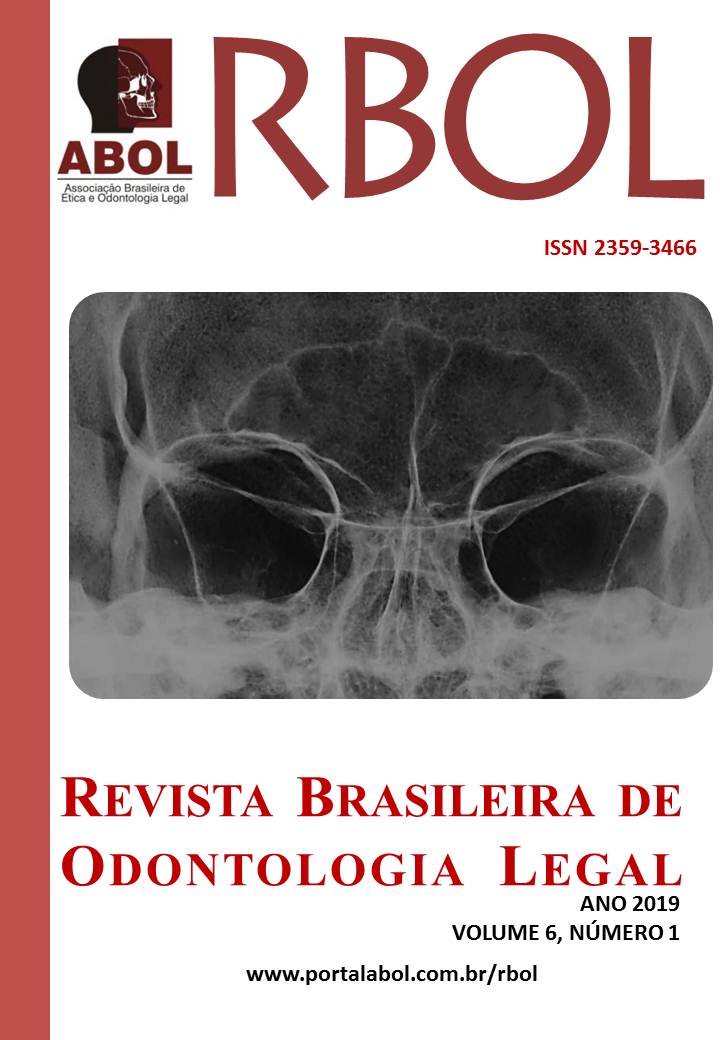MACROSTRUCTURE OF TEETH RESTORED WITH DIFFERENT DENTAL MATERIALS ANALYZED AFTER THERMAL INVERSION
DOI:
https://doi.org/10.21117/rbol.v6i1.210Palavras-chave:
Dental materials, Forensic dentistry, Forensic sciences, Human identificationResumo
Objective: This study aimed to investigate the macrostructure of teeth restored with different dental materials after thermal inversion. Material and methods: The sample consisted of 16 bovine mandibular incisors. Half of the teeth underwent class V restorations with amalgam (Amalgam GS 80, SDI Dental Ltd., Dublin, Ireland), while the other half was restored with composite (Charisma, Kulzer GmbH, Hanau, Germany). During 30 minutes the teeth were exposed to heating at 100oC, 200oC, 300oC and 400oC. Next, cooling was performed in half of the sample using a fan (slowly) and in the other half using water (quickly). Qualitative analysis was performed to detect eventual macroscopic alterations in the teeth, especially considering: I) the color of the restoration; II) the structure of the restoration; III) fitting of the restoration in the cavity; IV) main alteration of the restoration from the original form; V) main alteration of the tooth from the original form. Results: Different macroscopic alterations were observed after slow and quick cooling of the amalgam after heating at 200oC, 300oC and 400oC, while for the composite the alterations were detected only after heating at 400oC. Conclusion: Optimal human identification performances and forensic reports must consider the eventual macroscopic alterations in dental restorations and teeth detected in charred bodies retrieved from the water.Referências
International Crime Police Organization. Disaster victim identification guide. Lyon: Interpol; 2014.
Silva RF, Felter M, Tolentino PHMP, Andrade MGBA, Rodriguez LG, Franco A. Forensic importance of intraoral photographs for human identification in dental autopsies – a case report. Biosci J. 2017; 33(6):1696-1700. http://dx.doi.org/10.14393/BJ-v33n6a2017-38605.
Silva RF, Franco A, Picoli FF, Rodrigues LG, Tolentino PHMP, Mendes SDSC. Computerized dental delimitation of incisal edges in smile photographs with forensic purposes. Rev Bras Odont Legal RBOL. 2016; 3(2):74-82. http://dx.doi.org/10.21117/rbol.v3i2.7.
Lima KF, Figueiredo BMJ, Guimarães MA, Silva RHA. Post mortem dental information for human identification: description of the protocol used in LAF-CEMEL. Rev Bras Odont Legal RBOL. 2018; 5(1):48-60. http://dx.doi.org/10.21117/rbol.v5i1.123.
Franco A, Thevissen P, Coudyzer W, Develter W, Van de Voorde W, Oyen R et al. Feasibility and validation of virtual autopsy for dental identification using the Interpol dental codes. J Forensic Leg Med. 2013; 20(4):248-54. http://dx.doi.org/10.1016/j.jflm.2012.09.021
Nogueira TE, Bandeira ACFM, Leles CR, Silva RF. Use of QR code as personal identification of complete dentures – literature review. Rev Bras Odont Legal RBOL. 2018; 5(1):61-7. http://dx.doi.org/10.21117/rbol.v5i1.160.
Almeida CAP. Proposta de protocolo para identificação odontolegal em desastres de massa. Tese (Doutorado). Universidade Estadual de Campinas. Campinas, SP; 2000.
Francsico RA, Villalobos MIOB, Ortiz AG, Biazevic MGH, Guimarães MA, Silva RHA. The use of human teeth in identification: epidemiological data from an anthropology lab in Brazil. Biosci J. 2016; 32(2):560-5. http://dx.doi.org/10.14393/BJ-v32n2a2016-30195
Mondelli J. Fundamentos de dentística operatória. 2a ed. São Paulo: Santos; 2017.
Baratieri LN, Monteiro Júnior S, Melo TS. Odontologia restauradora: fundamentos e técnicas. 1a ed. São Paulo: Santos; 2010.
Biancalana RC, Vicente SAF, Silva RHA, Pires-de-Souza FCP. Color stability of dental restorative materials submitted to heat sources for forensic purposes. J. Forensic Leg Med. 2017; 62(2):355-60. http://dx.doi.org/10.1111/1556-4029.13292
Pol CA, Ghige SK, Gosavi SR, Hazarey VK. Effects of elevated temperatures on different restorative materials - an aid to forensic identification processes. J Forensic Dent Sci. 2015; 7(2):148-52. http://dx.doi.org/10.4103/0975-1475.154591
Bagdey S, Moharil R, Dive A, Thakur S, Bodhade A, Dhobley A. Effect of various temperatures on restored and unrestored teeth: a forensic study. J Forensic Dent Sci. 2014; 6(1):62-6. http://dx.doi.org/10.4103/0975-1475.127777
Spadacio C, Oliveira OF, Benedicto EM, Daruge Júnior E, Paranhos LR. Análise do comportamento de restaurações estéticas sob a ação de calor e sua importância no processo de identificação humana. RFO 2011; 16(3):267-72.
Brandão RB, Martin CC, Catirse AB, Silva MC, Evison MP, Guimarães MA. Heat induced changes to dental resin composites: a reference in forensic investigations? J Forensic Sci. 2007; 52(4):913-9. http://dx.doi.org/10.1111/j.1556-4029.2007.00474.x
Miguel R, Sosa JA. Comportamento de las piezas dentárias y sus restauraciones frente a la acción de la temperatura. Rev FOUBA. 1995; 16(41):75-80.
Pueyo VM, Garrido BR, Sanchez JA. Odontologia legal y forense. 1a ed. Barcelona: Masson; 1994.
Patidar KA, Parwani R, Wanjari S. Effects of high temperature on different restorations in forensic identification: dental samples and mandible. J Forensic Dent Sci. 2010; 2(1):37-43. http://dx.doi.org/10.4103/0974-2948.71056.
Anusavice KJ, Brantley WA. Propriedades físicas dos materiais dentários. In: Anusavice KJ. Phillips materiais dentários. 11a ed. Philadelphia: Saunders Elsevier; 2005.
Reis A, Loguercio AD, Bauer JRO, Mondelli J. Amálgama. In: Reis A, Loguercio AD. Materiais dentários diretos - dos fundamentos à aplicação clínica. 1a ed. São Paulo: Santos; 2007.
Downloads
Publicado
Edição
Seção
Licença
Os autores deverão encaminhar por email, devidamente assinada pelos autores ou pelo autor responsável pelo trabalho, a declaração de responsabilidade e transferência de direitos autorais para a RBOL, conforme modelo abaixo.
DECLARAÇÃO DE RESPONSABILIDADE E TRANSFERÊNCIA DE DIREITOS AUTORAIS
Eu (Nós), listar os nomes completos dos autores, transfiro(rimos) todos os direitos autorais do artigo intitulado: colocar o título à Revista Brasileira de Odontologia Legal - RBOL.
Declaro(amos) que o trabalho mencionado é original, não é resultante de plágio, que não foi publicado e não está sendo considerado para publicação em outra revista, quer seja no formato impresso ou no eletrônico.
Declaro(amos) que o presente trabalho não apresenta conflitos de interesse pessoais, empresariais ou governamentais que poderiam comprometer a obtenção e divulgação dos resultados bem como a discussão e conclusão do estudo.
Declaro(amos) que o presente trabalho foi totalmente custeado por seus autores. Em caso de financiamento, identificar qual a empresa, governo ou agência financiadora.
Local, data, mês e ano.
Nome e assinatura do autor responsável (ou de todos os autores).

